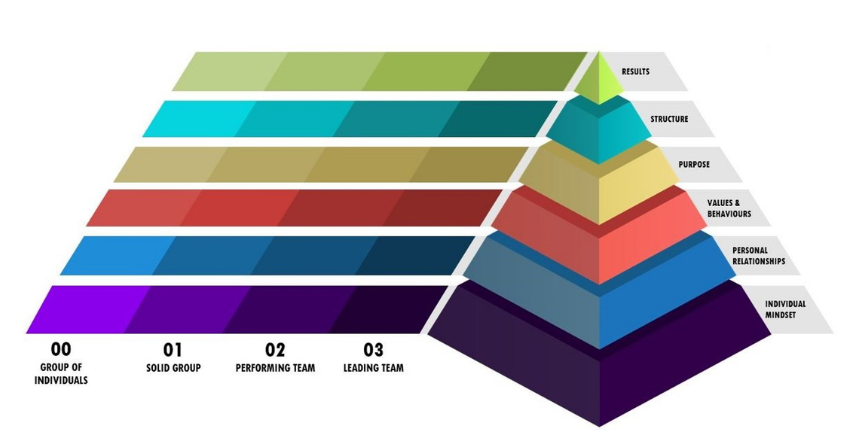 By David Byrum
By David Byrum
When people ask how do we go about helping companies move a group of people that work together into a high functioning and high performing team, I always like to start with a saying often used by my colleague Corinne Canter .. “There is absolutely an “I” in team, and it’s YOU, and building high performing teams starts with YOU as an individual”. This is because we always need to show up with our own individual thinking and behaviour within a team, yes we actually have to choose the mindset and ideology to want to be part of the team to begin with.
The basic premises of building a high performing team;
- They Develop over time & continually evolve as relationships build
- Starts with the individual mindset of each team member
- Focuses on the individual impact you have on your peers within a team
There are 6 key ingredients to building a high functioning team that maximises synergy and ultimately performance, a team development pyramid of sorts. The layers or levels of development are:
INDIVIDUAL MINDSET
You absolutely have to start with the foundation that makes a team … and that is focusing on the individual first and foremost. At this base level we ask people “what is the individual mindset you bring to your team”, and “how does it affect the greater partnership of the team”? Of course, you need to look at the team as a whole, bring greater awareness of its capabilities, strengths and resources but helping people understand how they show up within their team, the self-awareness around their individual mindset in the role they play and how committed they are will obviously influence the effectiveness and outcome of the team.
PERSONAL RELATIONSHIPS
We then ask people “what is the quality of the relationship you have with other members of the team”? It goes beyond knowing their birthday or their kids names, it’s asking yourself “do I have their back, and do they have mine”? Open communication is key to the partnership. Trust is also a huge element of a successful team – ‘trust’ is a loose term thrown around easily, for me I like David Maister’s formula for the TRUST EQUATION: Credibility + Reliability + Intimacy divided by Self Interest (1).
The denominator is Self interest or Self Orientation – which is evaluating how much a person cares and is aware of other people. It shows up a in a low self-orientation person as very intentionally concerned for the needs of others.
A high level of self-orientation results in a low level of trustworthiness, regardless how good a person is in credibility, reliability and intimacy. In other words it takes 3 things to build trust and only one to take trust away.

Ultimately a team has to ask itself “are we in this together, are we a partnership”? The affiliative styles of the circumplex underscore this belief – team members showing care, interest and respect for each other help to promote a healthy team rapport and relationship.
VALUES & BEHAVIOURS
The team then has to ask itself “what do we stand for as a team, what values do we aspire to, how do we measure our success behaviourally”? Team values link through and support the greater organisational mission. By building and strengthening the team values you then have the ability to measure them and hold everyone in the team to account. Utilising the GSI (Group Styles Inventory™) is a good way to set the ideal values of a team as well as measure the actual behaviours people are experiencing in the team. Having the conversation and identifying actions to constantly improve separates good teams and high performing teams.
PURPOSE
Ask the team “why do we exist, what gap would occur if we were not around”? Having a clear concise message around what difference a team makes to their organisation and its mission and purpose gives clarity to the value each team member brings.
STRUCTURE
Supporting your team with protocols, systems and processes are key to helping groups mechanically operate as a team. An example of this is meetings. Asking the team “how often do we meet, where do we meet, how do we structure that meeting, what is the agenda and how do we communicate within it” are all important. Having the tactical and transactional steps in place are necessary for a team to perform.
Another example, is the roles that each person plays within the team. Who is the decision maker, who is the planner, the problem solver, the pacifier, the comedian, the facilitator, the adjudicator and meeting closer. People tend to naturally fall into these roles, but ask your team what role they’d like to fulfil.
It is important to note that structure facilitates a high performing team, however, it does not create a high performing team. The best structures with poor behaviours and no relationships will not create a high performing team.
RESULTS
Understanding why we’re here helps to gauge the team results. We need to balance organisational metrics, standard financial metrics, and people and culture success planning metrics. We like to highlight that all teams and games have a scoreboard. What is your scoreboard to check progress?
In summary, teams that do not perform with synergy are simply groups of individuals that come together collectively at regular intervals. If you ask an individual what they are measured by within their team and they answer by ‘their output alone’ then they’re just a group of individuals simply looking after their own patch.
A leading team will be nimble and ever-changing, new members will be well inducted with a high understanding of their value and purpose within the team.
Overall, achieving a team with a high functioning means working on a series of individual steps and activities that focus on:
- Individual relationships
- Behaviours and values
- Good protocols and structures
- Keeping your eye on the prize, the results.